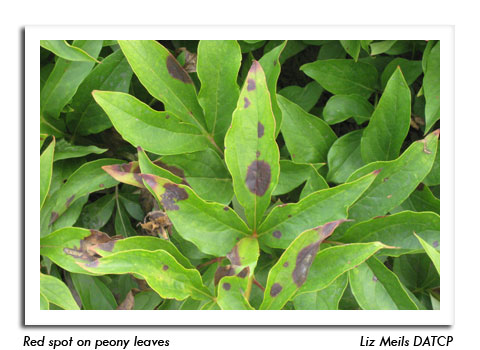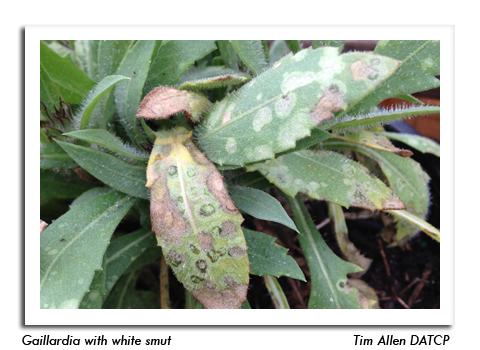
 |
|
|
Nursery & Forest
Volume 59 Number 9 Date 06/26/2014 APPLE SCAB - Ornamental crabapple trees in Dane and Jefferson counties were expressing light to moderate leaf spotting symptoms associated with this fungal disease. Infected leaves initially develop brown or olive lesions that later turn black. These primary spring infections produce secondary spores which continue to infect leaves and fruits during wet periods throughout the growing season, often resulting in severe defoliation. Cultural practices such as pruning, planting resistant varieties, thorough sanitation, and watering can usually control apple scab. Fallen leaves should be removed in autumn to reduce the amount of inoculum available to start the infection cycle the following year. Fungicides are generally not warranted for nursery stock, except in years when the disease is particularly severe. FIR-FERN RUST - This needle rust was observed on Frasier firs grown in close proximity to ferns in an Eau Claire County Christmas tree field. Symptoms on firs include chlorotic, yellow needles with white fruiting bodies on the undersides. Some fir-fern rust species develop on and kill infected fir needles in one season, subsequently overwintering on the alternate fern host. Other rust species overwinter in living fir needles and twigs and kill the infected needles over the course of several seasons. Infected needles dry out and drop prematurely, often in quantities that render trees unmarketable at fall harvest. Management options include removing alternate fern hosts, particularly bracken ferns, from the periphery and within fields by mowing or applying herbicide sprays. VENTURIA SHOOT BLIGHT - Quaking aspen at nurseries in Dane County are showing the black, blighted shoots indicative of this fungal disorder. Early symptoms appear in May as irregular brown or black spots on the leaf surfaces, which later expand to new shoots and cause the characteristic shepherd?s crook. Secondary infection cycles can occur throughout the shoot elongation period, especially during extended periods of wet weather. Pruning blighted shoots below the margin between healthy and diseased tissue is advised. PEONY RED SPOT - Peonies at garden centers in Waushara County were infected with this fungal disease, characterized by small, circular, reddish or purplish leaf spots that appear on the upper surfaces of young leaves shortly before bloom. Later in the season the lesions expand and merge to form large, irregular blighted areas. All above-ground parts of the peony are susceptible to red spot. This disease is an aesthetic problem that can be controlled by cutting back plants to ground level in fall and destroying infected foliage. Fungicides labeled for peony red spot are also an effective control and should be applied to the soil around plants in spring, when new shoots are 2-4 inches tall. A second post-emergence application may be necessary. -- Ellen Hermanson, DATCP Nursery Inspector WHITE SMUT ON GAILLARDIA - This fungal disease was found in eastern Bayfield County on Gaillardia (blanket flowers) plants at a landscaper's holding yard. White smut can be identified by white to yellow-green spots up to ¼ inch in diameter that sometimes have smaller brownish spots at the center. The fungus is seed-borne and likely overwintered as spores amidst plant material. Proper sanitation and increased plant spacing will help reduce its occurrence. Removal of affected leaves and severely infected plants is also recommended. COLUMBINE SAWFLY - The green, caterpillar-like larvae of this sawfly are feeding on the leaves of columbine in Bayfield County, severely defoliating plants in a grower's field. Damage may be reduced by manually removing the larvae and infested leaves. Most garden insecticides or insecticidal soaps are also effective. The columbine sawfly has just one generation per year, so scouting beyond June is not necessary. MAPLE BLADDER GALL MITE - Infestations of this maple foliar pest were evident on silver maple leaves in northern Douglas County. The maple bladder gall mite overwinters in the buds or just under bud scales on young silver and red maples, and beneath bark scales on older trees. The mites enter leaves as expansion begins in spring and initiate abnormal leaf growth, which produces noticeable yellowish-green leaf protrusions that quickly turn pink to red and eventually black. The galls are most common on the lower, interior part of the crown. No corrective action is needed since maple bladder galls seldom, if ever, cause permanent injury to a tree. -- Tim Allen, DATCP Nursery Inspector 





|
|
|